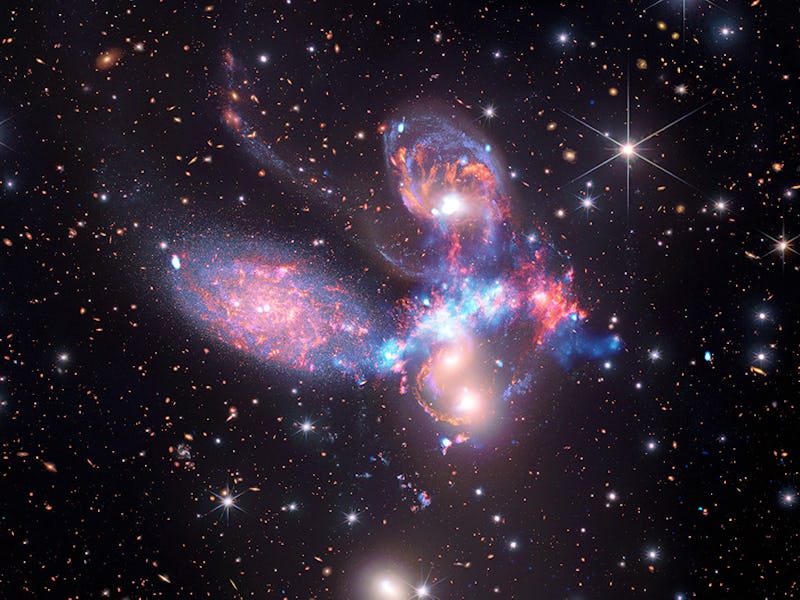Enhanced! NASA reveals turbulent hot spots within Webb’s famous first images
A NASA X-ray spacecraft delivers new dimensions to the first images from the Webb telescope.

Astronomers splashed new colors onto the famous first images from the James Webb Space Telescope.
Images touch people in a way that words cannot. The unprecedented clarity of the Webb telescope’s first scientific images dazzled people across the world when they became public on July 12, 2022. Three months later, the team working on NASA’s Chandra X-Ray Observatory released new images of the same target objects: Stephan's Quintet, galaxy cluster SMACS 0723.3–7327, and the “Cosmic Cliffs” of the Carina Nebula. An image that Webb later took of the Cartwheel Galaxy also got an update. All these visuals add more “turbulent” information about these structures and give the originals a whole new dimension.
The full set of images is available here. To appreciate the new data, Inverse set some of them side by side with their corresponding original image.
Stephan’s Quintet. Chandra X-ray data (right) appears as a bright blue band where galaxies are colliding. “The Chandra data (light blue) of this system has uncovered a shock wave that heats gas to tens of millions of degrees, as one of the galaxies passes through the others at speeds of around 2 million miles per hour,” Chandra officials wrote on October 4, 2022. On the left is the Webb image published July 12, 2022.
Chandra launched in 1999 and is named after Indian-American Nobel laureate Subrahmanyan Chandrasekhar. The new images became public the same day the 2022 Nobel Prize in Physics, which highlighted achievements in quantum entanglement, were announced, coincidentally.
X-Ray observations from the telescope “generally show higher-energy phenomena,” Chandra officials wrote in an image description published Tuesday. That could include superheated gas and what is left behind after a star explodes.
The Webb image of galaxy cluster SMACS J0723 (left) is also called “Webb’s First Deep Field.” President Joe Biden announced the image on July 11, 2022. Chandra also peered into this region 4.2 billion light-years away, and its X-ray image (right) show what NASA officials call “vast reservoirs of superheated gas... with temperatures of tens of millions of degrees.” The X-ray data appears as the blue hazy sphere in the middle.
“To the human eye, space appears serene and void,” Chandra officials wrote in a 2005 mission outline. “It is neither. To the ‘eye’ of an X-ray telescope, the universe is totally different — a violent, vibrant, and ever-changing place.”
The new Webb telescope studies the Universe through another wavelength called infrared. Its location, about a million miles away from Earth, couples with Webb’s cryocooler to provide a frigid environment from which the telescope can “record the feeble light” from distant stars and galaxies.
NASA published Webb’s image of the “Cosmic Cliffs” of the Carina Nebula (left) on July 12, 2022. The Chandra X-Ray data of the same region (right) shows emissions (pink) from the three hottest and most massive stars in the nebula’s star cluster. Officials say that younger stars are brighter in X-Rays than older stars, allowing astronomers to sort stars based on age.
“[JWST] is designed to work in concert with NASA's many other telescopes,” officials write. “These new versions of Webb’s first images combine its infrared data with X-rays collected by NASA’s Chandra X-ray Observatory, underscoring how the power of any of these telescopes is only enhanced when joined with others.”
And this is just the start. Officials write that astronomers intend to combine data from these telescopes in the future across more celestial targets.